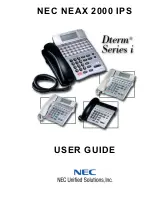
Section 400-Programming
FF1: System Programming
576-13-400
DBS 576 (USA) issued 05/20/98
●
Page 1-127
FF1
System
FF2
Trunks
FF3
Extensions
FF4
FF-/Soft Keys
FF5
Groups
FF6
TRS/ARS
0
System
Configuration
FF7
Applications
FF8
Maintenance
Introduction
Appendix A
Appendix B
FF1
System
FF2
Trunks
FF3
Extensions
FF4
FF-/Soft Keys
FF5
Groups
FF6
TRS/ARS
0
System
Configuration
FF7
Applications
FF8
Maintenance
Introduction
Appendix A
Appendix B
FF1 1 02: Trunk Timer 2
Notes:
This address does not affect DID calls, which (if unanswered) will continue to ring an idle extension
indefinitely, or until the user performs another action on the phone (such as accessing another trunk for
an outgoing call) while the DID call is ringing. At that point, the DID call will change to multiple-
incoming ringing. NOTE: The user will not be able to perform another action on the phone if the
extension’s Trunk Key Operation: Direct Calls (pg. 3-14) setting is left at “1=Ignore key press
(default),” in which case the DID call will continue to ring the extension.
Multiple-Incoming Ringing: An incoming trunk call will ring on all extensions that have a line
appearance (FF-key) for that trunk. The trunk’s Ring Type must be set to “0=Multiple Incoming
(default)” in FF2. Trunks are assigned to FF-keys in FF4.
DID (Direct Inward Dial): An outside caller can reach an internal extension directly by dialing a 7-
digit CO phone number. The DID trunk passes the last 2 to 4 digits of the phone number to the PBX,
and the digits become (or are modified to become) the equivalent of an extension number. DID trunks
can’t be used for outgoing calls (no dialtone offered). To set up DID, set the Analog-CO, ISDN, or T1-
CO trunks for DID in the Ring Type addresses (FF2). Enter the DID numbers and assign their ring and
delayed-ring destinations in FF1 4: DID/DNIS Tables (see pg. 1-168).
DISA (Direct Inward System Access): By dialing the DISA trunk’s CO phone number, an outside
caller can dial into the phone system, and have full access to all the system’s features without going
through the Attendant (including the ability to transfer himself to different extensions, or dial-out on
another trunk). To set up DISA, set the Analog-CO, ISDN, or T1-CO trunks for DISA service in the
Ring Type addresses (FF2). Create DISA ID Codes and assign TRS Classes to them in FF1 0 26:
DISA ID Codes (see pg. 1-113).
Related Programming:
DISA No-Answer Timeout (pg. 1-31) FF1 0 02 0017 Hold (0 or 1) Hold
DISA No-Answer Timer #1
(all CPCs) - Version 1.0 or higher
Set how long the system will wait before changing an unanswered DISA call
to multiple-incoming ringing.
FF1 1 02 0001 Hold (0-255) Hold
0 = 5 seconds
1 = 1 second
2 = 2 seconds
...
255 = 255 seconds
default: 30 seconds
(setting=no. of seconds):
/ ) /)
















































